University of New South Wales
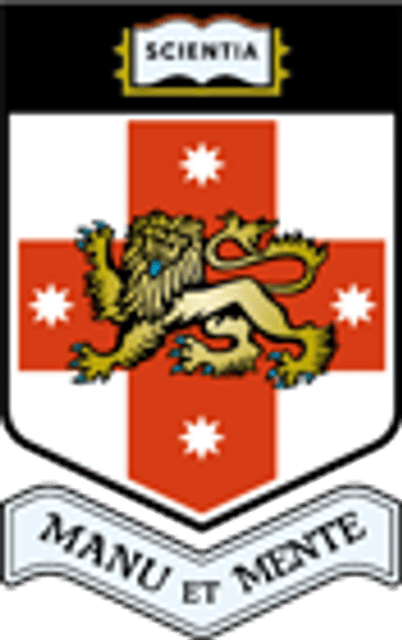
University of New South Wales

| New South Wales University of Technology (1949–1958) | |
| Motto | Scientia Manu et Mente(Latin) |
| "Knowledge by Hand and Mind" | |
| Type | Public |
| Established | 1949 |
| Endowment | [1] |
| Chancellor | David Gonski |
| President | Ian Jacobs |
| 6,739[2] | |
| Students | 62,509[2] |
| Undergraduates | 35,679[3] |
| Postgraduates | 18,226[3] |
| Location | |
| Campus | Urban, parks, 38 hectares (94 acres) |
| Colours | |
| Affiliations | |
| Website | unsw.edu.au[87] |
| University rankings | |
| University of New South Wales | |
| QSWorld[37] | 43 |
| THE-WURWorld[38] | 71 |
| ARWUWorld[39] | 94 |
| USNWRWorld[40] | 70 |
| CWTS LeidenWorld[41] | 55 (all sciences) |
| Australian rankings | |
| QSNational[37] | 3 |
| THE-WURNational[42] | 5 |
| ARWUNational[43] | 6 |
| USNWRNational[44] | 6 |
| CWTS LeidenNational[41] | 4 |
| ERANational[45] | 1 |
The University of New South Wales (UNSW; branded as UNSW Sydney [5]) is an Australian public research university located in the Sydney suburb of Kensington. Out of all Australian universities, UNSW has the highest median ATAR and attracts the highest number of top 500 students.[6] Established in 1949, it is ranked 4th in Australia, 43rd in the world according to the 2020 QS World University Rankings.[7] The University comprises nine faculties, through which it offers bachelor, master and doctoral degrees. The main campus is located on a 38-hectare (94-acre) site in the Sydney suburb of Kensington, 7 km (about 4.3 miles) from the Sydney central business district. The creative arts faculty, UNSW Art & Design, is located in Paddington, UNSW Canberra is located at the Australian Defence Force Academy in Canberra and sub-campuses are located in the Sydney CBD, the suburbs of Randwick and Coogee. Research stations are located throughout the state of New South Wales.[8] UNSW is one of the founding members of the Group of Eight, a coalition of Australian research-intensive universities, and of Universitas 21, a global network of research universities. It has international exchange and research partnerships with over 200 universities around the world.
| New South Wales University of Technology (1949–1958) | |
| Motto | Scientia Manu et Mente(Latin) |
| "Knowledge by Hand and Mind" | |
| Type | Public |
| Established | 1949 |
| Endowment | [1] |
| Chancellor | David Gonski |
| President | Ian Jacobs |
| 6,739[2] | |
| Students | 62,509[2] |
| Undergraduates | 35,679[3] |
| Postgraduates | 18,226[3] |
| Location | |
| Campus | Urban, parks, 38 hectares (94 acres) |
| Colours | |
| Affiliations | |
| Website | unsw.edu.au[87] |
| University rankings | |
| University of New South Wales | |
| QSWorld[37] | 43 |
| THE-WURWorld[38] | 71 |
| ARWUWorld[39] | 94 |
| USNWRWorld[40] | 70 |
| CWTS LeidenWorld[41] | 55 (all sciences) |
| Australian rankings | |
| QSNational[37] | 3 |
| THE-WURNational[42] | 5 |
| ARWUNational[43] | 6 |
| USNWRNational[44] | 6 |
| CWTS LeidenNational[41] | 4 |
| ERANational[45] | 1 |
History
Foundation
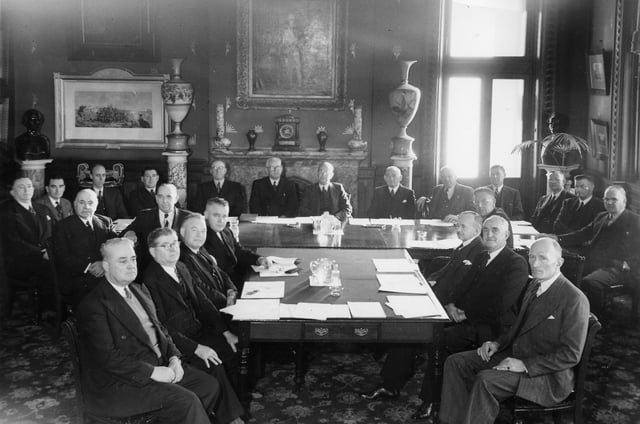
University council's first meeting in 1949
The origins of the university can be traced to the Sydney Mechanics' School of Arts established in 1833 and the Sydney Technical College established in 1878.[9] These institutions were established to meet the growing demand for capabilities in new technologies as the New South Wales economy shifted from its pastoral base to industries fueled by the industrial age.[9]
The idea of founding the university originated from the crisis demands of World War II, during which the nation's attention was drawn to the critical role that science and technology played in transforming an agricultural society into a modern and industrial one.[10] The post-war Labor government of New South Wales recognised the increasing need to have a university specialised in training high-quality engineers and technology-related professionals in numbers beyond that of the capacity and characteristics of the existing University of Sydney.[10] This led to the proposal to establish the Institute of Technology, submitted by the then New South Wales Minister for Education Bob Heffron, accepted on 9 July 1946.
The university, originally named the "New South Wales University of Technology", gained its statutory status through the enactment of the New South Wales University of Technology Act 1949 (NSW) by the Parliament of New South Wales in Sydney in 1949.
Early years
In March 1948, classes commenced with a first intake of 46 students pursuing programs including civil engineering, mechanical engineering, mining engineering and electrical engineering.[11] At that time the thesis programs were innovative. Each course embodied a specified and substantial period of practical training in the relevant industry. It was also unprecedented for tertiary institutions at that time to include compulsory instruction in humanities.[10]
Initially, the university operated from the inner Sydney Technical College city campus in Ultimo as a separate institution from the College. However, in 1951, the Parliament of New South Wales passed the New South Wales University of Technology (Construction) Act 1951 (NSW) to provide funding and allow buildings to be erected at the Kensington site where the university is now located.
Expansion
In 1958, the university's name was changed to the "University of New South Wales" to reflect its transformation from a technology-based institution to a generalist university.
In 1960, it established faculties of arts and medicine and shortly after decided to add the Faculty of Law, which came into being in 1971.[13]
The university's first director was Arthur Denning (1949–1952), who made important contributions to founding the university. In 1953, he was replaced by Philip Baxter, who continued as vice-chancellor when this position's title was changed in 1955.[14] Baxter's dynamic, if authoritarian, management was central to the university's first 20 years. His visionary, but at times controversial, energies saw the university grow from a handful to 15,000 students by 1968.[15] The new vice-chancellor, Rupert Myers (1969–1981), brought consolidation and an urbane management style to a period of expanding student numbers, demand for change in university style and challenges of student unrest.
The stabilising techniques of the 1980s managed by the vice-chancellor, Michael Birt (1981–1992),[16] provided a firm base for the energetic corporatism and campus enhancements pursued by the subsequent vice-chancellor, John Niland (1992–2002). The 1990s saw the addition of fine arts to the university. The university established colleges in Newcastle (1951) and Wollongong (1961), which eventually became the University of Newcastle and the University of Wollongong in 1965 and 1975 respectively.
The former St George Institute of Education (part of the short-lived Sydney College of Advanced Education) amalgamated with the university from 1 January 1990, resulting in the formation of a School of Teacher Education at the former SGIE campus at Oatley. A School of Sports and Leisure Studies and a School of Arts and Music Education were also subsequently based at St George. The campus was closed in 1999.[17]
Recent history
In 2012 private sources contributed 45% of the university's annual funding.[15]
In 2003, the university was invited by Singapore's Economic Development Board to consider opening a campus there. Following a 2004 decision to proceed, the first phase of a planned $200 m campus opened in 2007. Students and staff were sent home and the campus closed after one semester following substantial financial losses.[21]
In 2019, the university moved to a trimester timetable as part of UNSW's 2025 Strategy.
Under the trimester timetable, the study load changed from offering four subjects per 13-week semester, to three subjects per 10-week term.[22]
Symbols
The Grant of Arms was made by the College of Arms on 3 March 1952. The grant reads:
- Argent on a Cross Gules a Lion passant guardant between four Mullets of eight points Or a Chief Sable charged with an open Book proper thereon the word "SCIENTIA" in letters also sable.[23]
The lion and the four stars of the Southern Cross on the St George's Cross have reference to the State of New South Wales which established the university; the open book with scientia ("knowledge") across its pages is a reminder of its purpose. The placement of scientia on the book was inspired by its appearance on the arms of the Imperial College of Science, Technology and Medicine formed in 1907. Beneath the shield is the motto Manu et Mente ("With hand and mind"), which was the motto of the Sydney Technical College from which the university developed.[24]
An update of the design and colours of the arms was undertaken in 1970, which provided a more contemporary design, yet retained all the arms' heraldic associations.
In 1994 the university title was added to the UNSW arms, as was the abbreviation "UNSW", to create the UNSW symbol which is used for everyday and marketing purposes.[24]
The ceremonial mace of the university is made of stainless steel with silver facings and a shaft of eumung timber. On the head are mounted four silver shields, two engraved with the arms of the State of New South Wales and two with the original-design arms of the university. A silver Waratah, NSW's floral emblem, surmounts the head. The mace was donated to the university by Broken Hill Proprietary Company Limited and was presented by the company's chairman, Colin Syme, on 6 December 1962.[25] A former NSW Government Architect, Cobden Parkes, was appointed as the first official mace-bearer.[26]
Campus
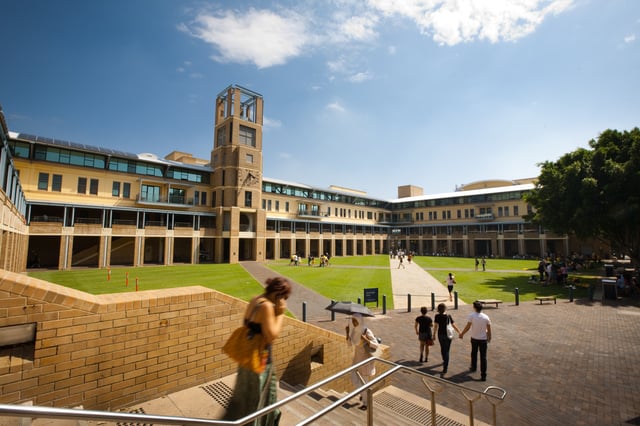
Quadrangle Building
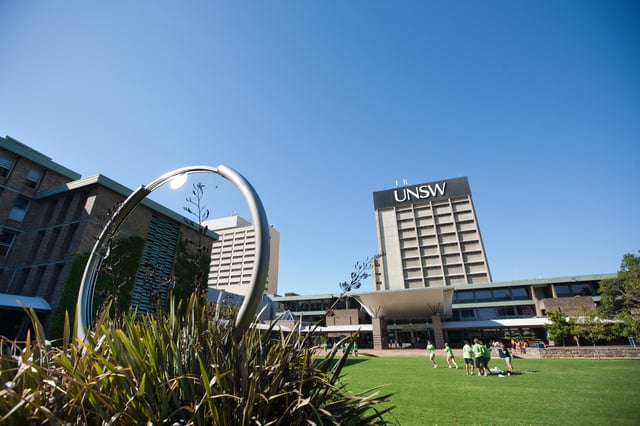
Library Lawn, upper campus
The main UNSW campus, where most faculties are situated, is in Kensington, Sydney. UNSW Art & Design is located in the inner suburb of Paddington, and UNSW Canberra at ADFA is situated in Canberra.
The main UNSW campus is divided geographically into two areas: upper campus and lower campus.
The lower campus area was vested in the university in two lots in December 1952 and June 1954.
The upper campus area was vested in the university in November 1959.[27] These two are separated mainly by an elevation rise between the quadrangle and the Scientia building.
It takes roughly fifteen minutes to walk from one extreme to the other.
The university also has additional campuses and field stations in Randwick, Coogee, Botany, Dee Why, Cowan, Manly Vale, Fowlers Gap, Albury, Port Macquarie, Coffs Harbour and at Bankstown Airport.
The university has a number of purpose-built research facilities, including:
UNSW Lowy Cancer Research Centre is a facility at the university. It is Australia's first facility bringing together researchers in childhood and adult cancers as well as one of the country's largest cancer research facilities, housing up to 400 researchers.
The Mark Wainwright Analytical Centre is a centre for the faculties of science, medicine and engineering. It is used to study the structure and composition of biological, chemical and physical materials.
Governance
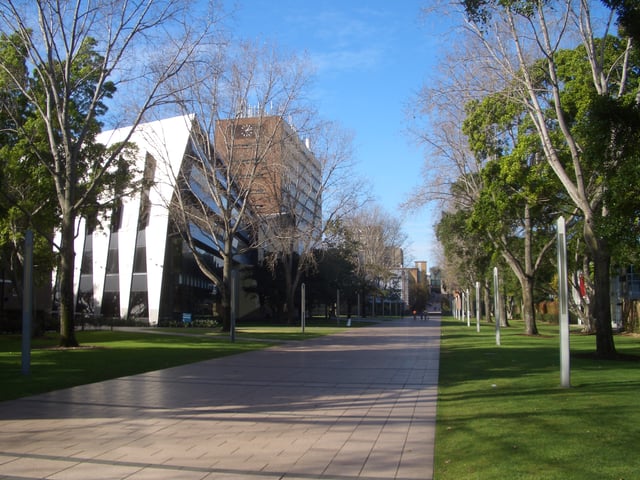
Main Walkway, Lower campus
The university is governed by the university council which is responsible for acting on the university's behalf to promote its objectives and interests.[30] The Council comprises 15 members including the chancellor, vice-chancellor, president of the academic board, two members appointed by the Minister for Education, five members appointed by the council, three members elected by university staff and two student elected members.[31]
The principal academic body is the academic board, which receives advice on academic matters from the faculties, college (Australian Defence Force Academy), and the boards of studies.[32] It is responsible for academic policy setting, academic strategy via its eight standing committees, approval and delivery of programs, and academic standards.[32] The board comprises 59 members, including the vice-chancellor, members of the executive team, deans and faculty presiding members, members elected from the academic staff and six from the student body.[33] The Board advises the Vice-Chancellor and council on matters relating to teaching, scholarship and research and takes decisions on delegation from the Council.
The chief executive officer of the university is the president and vice-chancellor,[34] currently Professor Ian Jacobs. The deputy vice-chancellors and pro-vice-chancellors form part of an executive team which are responsible for academic operations, research policy, research management, quality assurance and external relations including philanthropy and advancement.[32][35]
Each of the faculties has their respective boards are responsible for the teaching and examining of subjects within their scope.[36]
Academic profile
Faculties
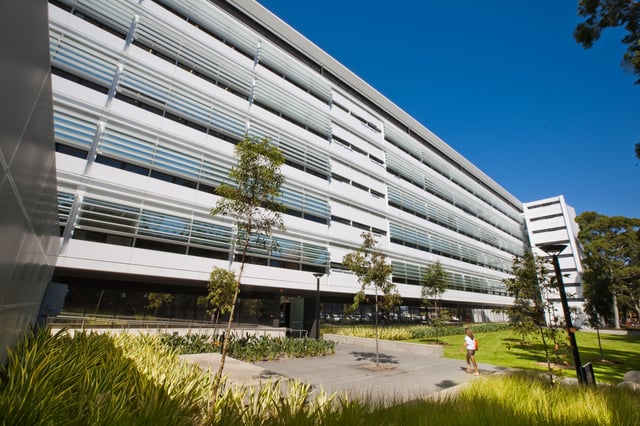
UNSW Business School

UNSW Built Environment
The university has nine faculties:
UNSW Art & Design
UNSW Arts and Social Sciences
UNSW Built Environment
UNSW Business School
UNSW Engineering
UNSW Law
UNSW Medicine
UNSW Science
UNSW Canberra at ADFA
The university also has an association with the National Institute of Dramatic Art.
University rankings
In the 2020 QS World University Rankings UNSW is ranked 43rd Globally (4th in Australia and 2nd in New South Wales),[37]15th in the world for Accounting and Finance (1st in Australia),[47] 14th for law (3rd in Australia),[48] and 12th in civil and structural engineering (1st in Australia),[49] 38th in Engineering and Technology discipline (1st in Australia).[50]
In the 2019 Academic Ranking of World Universities, UNSW is ranked 94th Globally and 6th in Australia.[51] In addition, UNSW has more subjects ranked in the Academic Ranking of World Universities than any other Australian university with 39 in the top 100, 22 in the top 50 and 3 in the top 10 in the world.[52] With 13 subjects ranked first in Australia: Finance (18th in the world), Water Resources (7th in the world), Management (51-75th in the world), Mechanical Engineering (45th in the world), Remote Sensing (13th in the world), Library and information science (23rd in the world), Civil Engineering (9th in the world), and Instrument Science and technology (51-75th in the world) etc.[53]
The Australian Good Universities Guide 2014 scored UNSW 5-star ratings across 10 categories, more than any other Australian university. Monash University ranked second with seven five stars, followed by ANU, Melbourne University and the University of Western Australia with six each.[54]
The Times Higher Education World University Rankings 2017 placed UNSW 78th in the world.[55]
UNSW has produced more millionaires than any other Australian university, according to the Spear's Wealth Management Survey.[56]
Engineers Australia ranked University of New South Wales as having the highest number of graduates in "Australia's Top 100 Influential Engineers 2013" list at 23%, followed by Monash University at 8%, the University of Western Australia, University of Sydney and the University of Queensland at 7%.[57]
Selection and entry
Entry to a particular undergraduate degree program generally requires a certain Australian Tertiary Admission Rank, which varies by course. Some programs also take into account, in addition to a particular ATAR mark, performance in specialised tests, such as the UMAT for medicine and the Law Admission Test for law.
In 2019, UNSW was the number one university preference for high school students in the State of New South Wales.[58]
UNSW offers several scholarships and support programs to high achieving students.
The Co-op program is a scholarship and industry engagement program awarded to students across many programs in the built environment, engineering, science and the Australian School of Business.[60] Students usually enter the program after an application and interview while in their final year of high school.
The university also offers Scientia Scholarships to a number of commencing students who performed exceptionally in the Higher School Certificate, which provide funding of $10,000 per year for the duration of the student's program.[61]
Student life
Accommodation
The university has a number of residential accommodation options, including Philip Baxter College, Basser College, Goldstein College, Fig Tree Hall, Colombo House, UNSW Hall, New College and New College Village, Warrane College; International House; Shalom College, and Creston College.
Study abroad
Overseas partner institutions include Princeton University, McGill University, University of Pennsylvania (inc. Wharton), Duke University, Johns Hopkins University, Brown University, Columbia University (summer law students only), University of California Berkeley, University of California Santa Cruz (inc. Baskin), UCLA, University of Michigan (inc. Ross), New York University (inc. Stern), University of Virginia, Mississippi State University, Cornell University, University of Connecticut, University of Texas at Austin (inc. McCombs), Maastricht University, University of Padua, University College London (law students only), University of Nottingham, Imperial College London, London School of Economics and ETH Zurich.[62]
Student projects

Sunswift eVe at the World Solar Challenge

UNSW National Snow Team winning the 2018 Championship
Students of the university are involved in a number of projects, including:
Sunswift Solar Racing Team, who hold the FIA world record for the fastest electric car over a 500 kilometres (310 mi) distance[63] and in 2015 are creating Australia's first road legal solar car to adhere to Australian Design Rules.
rUNSWift,[64] the university's team in the international RoboCup Standard Platform League competition, is the most successful team in the world with wins in 2000, 2001, 2003 and 2014 as well as coming second in 1999, 2002, 2006 and 2010.
BLUEsat Satellite (development in progress)
Impact Engineers[65] are a group of cross disciplinary humanitarian engineers aspiring to make a difference to the world’s developing communities.
Impact Engineers currently focus their efforts in rural Sri Lanka however over the next three to five years, they will expand to launch projects across multiple developing countries
UNSW Redback Racing[66] UNSW's entrant into the SAE-Australasia Formula SAE-A Competition (National winners in 2000)
The MAVSTAR[67] (Micro Aerial Vehicles for Search, Tracking And Reconnaissance) project to develop a team of cooperative micro aerial and unmanned ground vehicles.
The Developing Country Project[68] Second year thesis students doing Photovoltaic and Renewable Energy Engineering are able to get involved.
The project aims to assist villagers in developing countries to gain access to electricity to satisfy their energy needs in a clean and sustainable manner.
iGEM (International Genetically Engineered Machine) a worldwide synthetic biology competition. BABS UNSW entered their first team in 2015.
Arc @ UNSW Limited
Background
In 2005, the Federal Parliament passed legislation making membership of student unions voluntary for the first time. This policy, known as voluntary student unionism (VSU), threatened the funding model behind the four UNSW student organisations with compulsory membership provisions. A report commissioned by the university administration recommended that three of those organisations – the Student Guild of Undergraduates and Postgraduates, the University of New South Wales Union and the College of Fine Arts Students' Association – merge into a single student organisation, a structure in use at the University of Melbourne.[69]
ARC
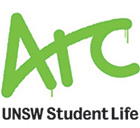
ARC Logo
Arc @ UNSW Limited is the student organisation at the University of New South Wales (UNSW) and is a not-for-profit public company based in Sydney, New South Wales, Australia.
The organisation supports the activities of student clubs, student volunteer programs such as orientation week, student publications, two student galleries (Kudos Gallery and AD Space), and houses an elected student representative council. Arc operates the Roundhouse entertainment venue, The Whitehouse bar and café and the Graduation & Gift Store on UNSW's main campus in Kensington. Arc also operates a student support service, providing legal and academic advocacy. Arc@UNSW exists independently from UNSW.
Arc was established on 15 August 2006 and launched early the following year, taking over the functions of three existing student organisations, the UNSW Student Guild, UNSW Union, and COFA Students' Association.[70]
Arc has three constitutional student bodies:
The student organisation is a major service provider on campus, running a number of retail outlets, student media such as Tharunka and an entertainment venue, the Roundhouse. The Arc Student Representative Council represents students to the university and nationally and fights for their rights. Arc also provides support and funding to university clubs and societies and runs student volunteer programs such as Orientation Week.
In 2007, the University of New South Wales Sports Association[74] and UNSW Lifestyle Centre merged to become UNSW Sport and Recreation then later absorbed into Arc @ UNSW to become Arc Sport.
It runs the external sporting facilities and services and supports the 30 UNSW affiliated sporting clubs that compete both at home and abroad.
Blitz
Blitz is a student publication, published online by Arc @ UNSW, based at the University of New South Wales.[75] Blitz under this name first appeared in session 2, 1988, but a similar "what's on" style publication had been issued by the then University Union since the early 1970s. Initially it consisted of a simple sheet or two of paper, but it evolved into a magazine style format in session two 1994[76] when a former editor from another student publication on campus, Tharunka, was hired to found a weekly "what's on" magazine. Blitz sometimes pays casual contributors for submitted articles and photographs, and employs a student online editor, a student designer, a student TV producer and a student radio producer.
Blitz typically covers the goings-on around campus and conducts interviews and publishes stories relating to current student activities. It widely publicises Arc services and activities on campus. Due to its non-partisan policy, it does not cover political issues, with the exception of voluntary student unionism. However, in 2004 an edition of Blitz was withdrawn by the student union because it contained a guide to rolling a joint. The editor Janet Duncan claimed there had been censorship of her editorial in the following issue.[77]The%20A]]Arc @ UNSW announced that the organisation would continue to publish the magazine after the introduction of voluntary student unionism in 2007.[[78]](https://openlibrary.org/search?q=%22What%20is%20VSU%3F%22.%20 [[CITE|78|https://openlibrary.org/search?q=%22What%20is%20VSU%3F%22.%20B%26T%20Magazine.%2017%20November%202006.)
Tharunka
Tharunka, meaning "message stick" in the language of the Aboriginal people local to the area, is a student newspaper originally published by the UNSW Students Union from 1953 until 1992, when that body was replaced by the University of New South Wales Student Guild. The Guild published Tharunka from 1993 until 2006 and the successor student organisation, Arc @ UNSW Limited, continued the publication of Tharunka from 2007.
Tharunka is managed by a small editorial team and actively solicits contributions from the UNSW student body. Including staff wages, the publication's budget is under $50,000 per year.[79]
Engagement with secondary and primary school students

Main Walkway during O-Week
UNSW engages with primary and secondary education, administering several national and international academic competitions for school age children.
These include:
The Australian Schools Science Competition – International Competitions and Assessments for Schools (ICAS) is conducted by Educational Assessment Australia, UNSW Global Pty Limited. UNSW Global is a not-for-profit provider of education, training and consulting services and a wholly owned enterprise of the University of New South Wales. It provides exams for students in Australia, New Zealand, Singapore, Brunei, Malaysia, South Africa, Indonesia, Hong Kong, India and the Pacific region. It caters to students from year 3 (Australia) through year 12, examining skills in English, mathematics, science, computers, writing and spelling.
International Competitions and Assessments for Schools-Mathematics – International Competitions and Assessments for Schools (ICAS). From 2003-05, ICAS-Mathematics was called Australasian Schools Mathematics Assessment. Prior to 2003, it was known as the Primary Schools Mathematics Competition and was targeted at primary schools.
The UNSW School Mathematics Competition [80] – Since 1962, the School of Mathematics and Statistics has run the UNSW School Mathematics Competition. This competition is a three-hour open book olympiad-style exam designed to assess mathematical insight and ingenuity rather than efficiency in tackling routine examples. Competition results as used as part of the assessment criteria for some university scholarships awarded by the UNSW School of Mathematics and Statistics.
The UNSW COMPUTING ProgComp [81] – Since 1997, The School of Computer Science and Engineering (UNSW COMPUTING) has run the UNSW COMPUTING ProgComp. This competition has the overall aim of raising awareness amongst high school students of the craft of programming and to encourage students to develop and apply their computing knowledge and skills.
The UNSW COMPUTING Robotics Workshops [82] – UNSW School of Computer Science and Engineering (UNSW COMPUTING) has developed specialised robotic workshops for school students. They focus on the use of the Lego NXT technology combined with the popular RoboCup Junior competition for schools. UNSW COMPUTING is also a national and NSW state sponsor of RoboCup Junior.
Educational Assessment Australia
Educational Assessment Australia (EAA) is a not-for-profit organisation owned by the University of New South Wales. It is a national and international educational assessment organisation specialising in large-scale assessment programs including the International Competitions and Assessments for Schools (ICAS) in Australia, New Zealand, Asia, India, South Africa and the Pacific region. EAA also provides scanning, data analysis and reporting services to commercial and educational institutions.
Notable people
Notable alumni include:
Michael Jankulovski, current Operations Administrator, CompliSpace
See also
New South Wales Systems Biology Initiative